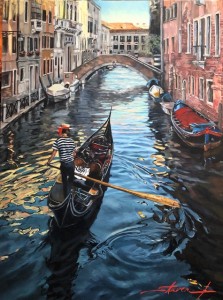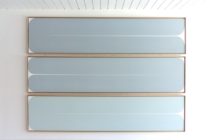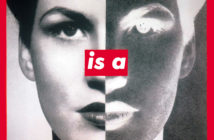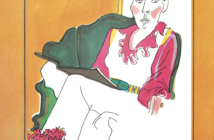Dear Artist,
My late friend Bert Oudendag used to open his oil tubes from their back-ends, squeeze the contents onto a steel tabouret and carefully fold in 50% by volume of stand oil, a small amount of copal varnish and a drop of cobalt dryer. He then put the mixture back into its tube and put the remainder in a glass jar. All this was in aid of an extended and more fluid brush stroke that gave his work a kind of Franz Hals character. He was particular about his stroke.
The unique blend of creativity and chemistry is what makes ours an interesting game. I’ve always noticed that when artists are fussy and particular, they are generally onto something. In Bert’s case: specific grey grounds, oily imprimatura (not linseed oil), rigid palette (five warms, one cool, plus black and white), unique brushes (specially trimmed), a special way of holding and using them (some for warm and some for cool), and unique hand-made boxes for painting storage. His studio was built around a vast bank-vault. Nobody else knew the combination. I watched him work on location many times. He would simply look for and find something that turned him on — he never asked why — then he quickly prepared himself, squeezed out, and began. Sometimes it was all over in twenty minutes. “Do not make the mistake of asking me my particularities,” he used to say, “You will have to find your own — otherwise you will lose your individuality.”
Bert kept as many as nine bicycles. “You must have a feeling for choice.” He was what we call a Renaissance man, but he always said it was important to have “French bicycles and Dutch paint.” Bert didn’t believe in wearing a bathing suit either. In the water in front of his beachside studio he would remove his Speedo and leave it attached to a fishing float. “Complete freedom is vital,” he said. When Bert died we let loose his float and impedimenta onto the high seas.
Best regards,
Robert

Portrait of Wim Haitsma’s mother, a present for what she did for him during the War
Groningen (Holland), 1945
by Egbert Oudendag
PS: “When painting the faces of young persons, use the yolk of the egg of a city hen, because they have lighter yolks than those of country hens.” (Cennino Cennini)
Esoterica: Cennino Cennini (1370-1440) was a Florentine painter who wrote a craftsman’s handbook that marks the transition between medieval and Renaissance art concepts. He offered detailed advice on the techniques of painting. At the same time he was one of the first to call for the use of imagination in art and to elevate painting from artisanship to fine art.
This letter was originally published as “Particularities” on December 11, 2001.
Recently, a letter arrived in the inbox from Wim Haitsma, which read in part, “Dear friend of Egbert Oudendag, I got from my late mother a portrait signed by Egbert Oudendag, 1945, painted in Groningen, Holland. She was 21 years old. As I understood it was a present for what she did for him in the war.” No other particularities are mentioned.
Featured Artist
A professional painter in both watercolor and oil for over 35 years, I have been creating plein air workshops in Europe for artists to join me since 1996. Plein air is one of the most exciting methods of painting, and I teach a very easy to learn way of capturing the light quickly, that any artist can apply to their own work during our adventures to Europe. Travel for artists is a great way to immerse yourself in painting and make great advances in your techniques by watching other professionals work, and by sharing your own ideas with other artists we all grow! Authentic locations, such as a 12th Century Castle in Ireland, a French Maison in the countryside of France, or an Italian Villa in an historic hilltop village in Italy are carefully chosen. We want our artists and non-painting guests to feel relaxed and at home, with en-suite bedrooms, excellent chef prepared cuisine, and convenient transfers to painting and exploring locations so you can be where you want to be to create. Join me on our next exciting journey!







14 Comments
Egbert was a really interesting, eccentric guy, and a terrific, very genuine artist. I’m really glad I had a chance to get to know him.
His paintings are so beautiful. Thank you for sharing them.
How did he put the paint back into the tube!?!?
The seashore paintings immediately made me think of the softness more often related to watercolours than oil.
Wonderful!
About putting what wouldn’t fit back in the tubes in glass jars: did he then fill with water or…? great column!
Thank you so much every different approach teaches us to explore more. The artist never stops learning and sharing
I still rely on Egbert
very helpful
Dan
Yes, Dan!
Egbert must have been a real artist and human. It was a very interesting story, thanks.
I enjoyed reading about the freedom Egbert describes and feels while swimming nude. It would appear this natural freedom transpired onto the canvas; meaning, every good idea in painting is worth exploring. Thanks for sharing his story that is so individual to the artist, himself.
Such an informative article. Egbert was my Dads cousin and he taught my dad and uncle to paint with this same passion. I too have been influenced by his simplicity.
Bert painted a largish nude oil of my mother Hazel Pinder, in Dundas, Ontario, probably in the early sixties. It hung in our house until my parents separated in the early seventies, they have both passed away, and I would like to know if you have any ideas of its whereabouts today.
I walk by Egbert ‘s house in White Rock almost everyday. I have fond memories of knocking on his door on Marine Drive after meeting his nephew in Dundas, Ontario. I was an art student at McMaster university and met his nephew by chance, who was Intrigued that I was travelling to White Rock to visit my parents who recently had moved here from Ontario. He asked me to pay a visit to his uncle,. It was a real treat and a memory I will always treasure! Egbert invited my mom and I into his home with open arms. He showed me his boxes and crates of 100’s of paintings which were his home. He showed us his bicycles of which he rode everyday. He showed us chin ups on his bar that hung by his doorway downstairs and was proud to say he does chin ups everyday. He had tins of tuna open and randomly placed for the cats to consume at their leisure. That was a day to remember. What an incredible memory. Elderly friends left me his painting called Okanagan Lake. 30 years later, I still call White Rock my home and smile softly as I pass by Egbert’s home.
I was the one you met in Dundas years ago. I miss both my Dad ( Egbert’s student) and him for both were great artist’s . Amazing to see your post . Small worlds.